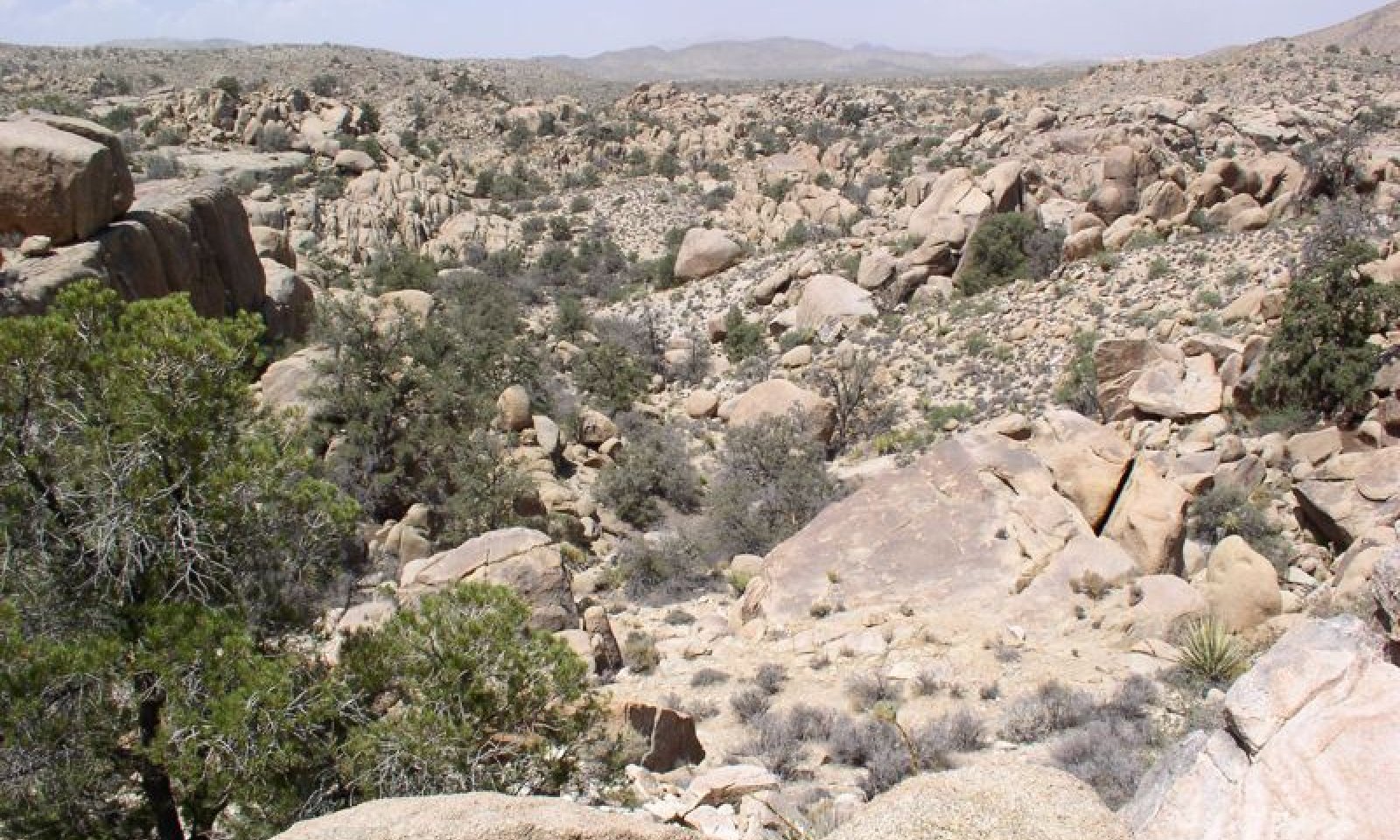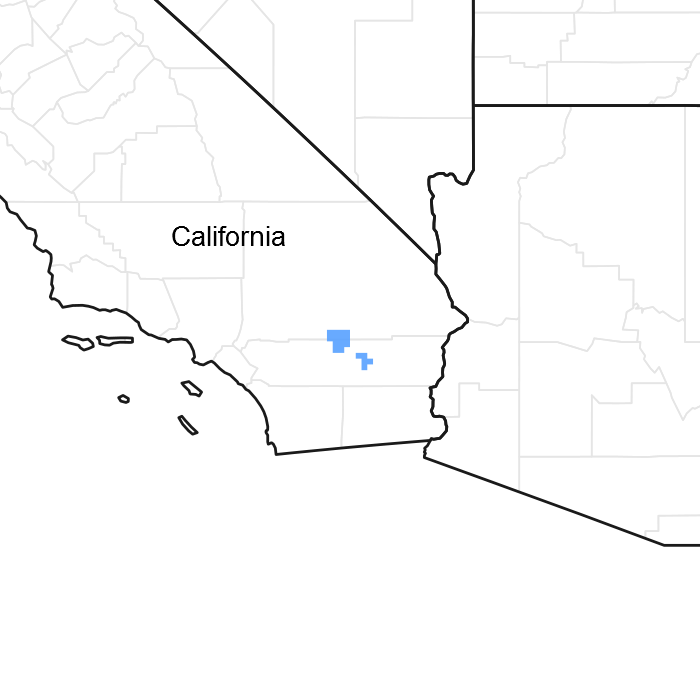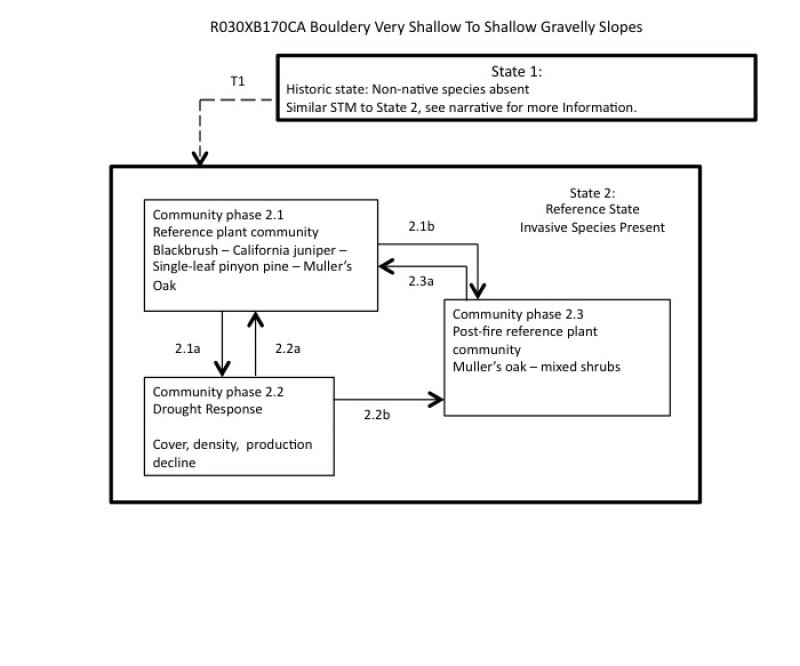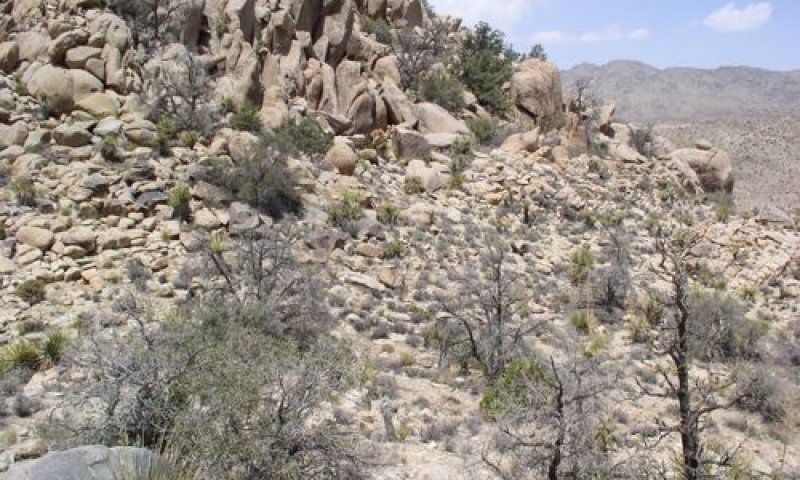

Natural Resources
Conservation Service
Ecological site R030XB170CA
Bouldery Very Shallow To Shallow Gravelly Slopes
Accessed: 12/21/2025
General information
Provisional. A provisional ecological site description has undergone quality control and quality assurance review. It contains a working state and transition model and enough information to identify the ecological site.

Figure 1. Mapped extent
Areas shown in blue indicate the maximum mapped extent of this ecological site. Other ecological sites likely occur within the highlighted areas. It is also possible for this ecological site to occur outside of highlighted areas if detailed soil survey has not been completed or recently updated.
MLRA notes
Major Land Resource Area (MLRA): 030X–Mojave Basin and Range
MLRA Description:
Major Land Resource Area (MLRA) 30, Mojave Desert, is found in southern California, southern Nevada, the extreme southwest corner of Utah and northwestern Arizona within the Basin and Range Province of the Intermontane Plateaus. The climate of the area is hot (primarily hyperthermic and thermic; however at higher elevations, generally above 5000 feet, mesic, cryic and frigid) and dry (aridic). Elevations range from below sea level to over 12,000 feet in the higher mountain areas found within the MLRA. Due to the extreme elevational range found within this MLRA, Land Resource Units (LRUs) were designated to group the MLRA into similar land units.
LRU Description:
This LRU (designated by ’XB’) is found across the eastern half of California, much of the mid-elevations of Nevada, the southernmost portions of western Utah, and the mid-elevations of northwestern Arizona. Elevations range from 1800 to 5000 feet and precipitation ranges from 4 to 9 inches per year, but is generally between 5-6 inches. This LRU is characterized primarily by the summer precipitation it receives, ranging from 18 – 35% but averages 25%. Summer precipitation falls between July and September in the form of rain, and winter precipitation falls starting in November and ends between February and March, also mostly in the form of rain; however it does receive between 0 and 3 inches of snow, with an average of 1 inch. The soil temperature regime is thermic and the soil moisture regime is typic-aridic. Vegetation includes creosote bush, burrobush, Nevada jointfir, ratany, Mojave yucca, Joshua tree, chollas, cactus, big galleta grass and several other warm season grasses. At the upper portions of the LRU, plant production and diversity are greater and blackbrush is a common dominant shrub.
Ecological Site Concept -
This site occurs at on steep rocky slopes with representative conditions between elevations of 3300 to 5800 feet on soils with a typic-aridic soil moisture regime. There is a high percentage of rock outcrops throughout the site, with very shallow to shallow sandy soils on slopes among outcrops. Single-leaf pinyon pine (Pinus monophylla), California juniper (Juniperus California) and Muller’s oak (Quercus cornelius-mulleri) dominate around rock outcrops, with blackbrush (Coleogyne ramosissima) dominant on shallow soils among outcrops. The roots of single-leaf pinyon pine, California juniper and Muller’s oak can access relatively high water content available in cracks in the weathering granitic bedrock of rock outcrops and between large surface fragments. Soil moisture is more limiting in the shallow soils among outcrops, and in the typic-aridic soil moisture regime of this ecological site, blackbrush, which is shallow-rooted and very drought-tolerant, dominates.
Data ranges in the physiographic data, climate data, water features, and soil data sections of this Ecological Site Description are based on all components (major and minor) correlated with this ecological site.
Associated sites
| R030XB140CA |
Shallow Hill 4-6" P.Z. R030XB140CA is found on narrow ridges and summits. White bursage (Ambrosia dumosa) and creosote bush (Larrea tridentata) are dominant species. |
|---|---|
| R030XB164CA |
Steep South Slopes R030XB164CA is found on warm slopes. Brittlebush (Encelia farinosa) is a dominant species. |
| R030XB166CA |
Dissected Pediment, Cool R030XB166CA is found on pediment downslope of R030XB170CA. The dominant species are blackbrush (Coloegyne ramosissima) and California juniper (Juniperus californica). |
| R030XB168CA |
Cool Deep Sandy Fans R030XB168CA is found on fan remnants downslope from this site. California juniper (Juniperus californica) and blackbrush (Coleogyne ramosissima) are dominant species. |
| R030XB172CA |
Warm Gravelly Shallow Hills R030XB172CA is found on lower elevation warmer slopes. Creosote bush (Larrea tridenatata) and Parish's goldeneye (Vigueira parishi) are dominant species. |
| R030XB183CA |
Loamy Very Deep Fan Remnants R030XB183CA is found on fan remnants downslope from this site. Blackbrush (Coleogyne ramosissima) and creosote bush (Larrea tridentata) are dominant species. |
| R030XB188CA |
Cool Shallow to Moderately Deep Fans R030XB188CA is found on pediments downslope from this ecological site. Blackbrush (Coleogyne ramosissima) and creosote bush (Larrea tridentata) are dominant species. |
| R030XB189CA |
Shallow Cool Hills R030XB189 is found on adjacent hills and mountains with a low percentage of large rock outcrop. The dominant species are blackbrush (Coleogyne ramosissima) and California juniper (Juniperus californica). |
| R030XB193CA |
Very Shallow To Moderately Deep Gravelly Slopes R030XB193CA is found on rocky warm thermic slopes. White bursage (Ambrosia dumosa), Jojoba (Simmondsia chinensis), Parish's goldeneye (Vigueira parishii), and waterjacket (Lycium andersonii) are important species. |
| R030XB225CA |
Warm Sloping Pediments R030XB225CA is found on pediments downlope from this site. White bursage (Ambrosia dumosa) and Hall's shrubby spurge (Tetracoccus hallii) are dominant species. |
| R030XD003CA |
Hyperthermic Steep South Slopes R030XD003CA is found on hyperthermic slopes. Brittlebush (Encelia farinosa) is the dominant species. |
| R030XE196CA |
Sandy Xeric-Intergrade Slopes R030XE196CA is found on slopes with a xeric intergrade soil moisture regime. Single-leaf pinyon pine (Pinus monophylla) and California juniper (Juniperus californica) are dominant species, and shrub diversity is high. |
Similar sites
| R030XB189CA |
Shallow Cool Hills R030XB189CA is found on hills without areas of large rock outcrop. The dominant species are blackbrush (Coleogyne ramosissima) and California juniper (Juniperus californica), and Muller oak (Quercus cornelius-mulleri) and singleleaf pinyon (Pinus monophylla) are trace if present. |
|---|---|
| R030XE196CA |
Sandy Xeric-Intergrade Slopes R030XE196CA is found on slopes with a xeric intergrade soil moisture regime. Single-leaf pinyon pine (Pinus monophylla) and California juniper (Juniperus californica) are dominant species, with a diverse shrub understory. Blackbrush (Coleogyne ramosissima), may be present, but is not a dominant species. |
| R030XE191CA |
Dry Sandy Mountain Slopes R030XE191CA is found on soils with a xeric intergrade soil moisture regime. Single-leaf pinyon pine and Muller's oak (Quercu cornelius-mulleri) dominate and are not restricted to rock outcrops. Blackbrush (Coleogyne ramosissima) is not a dominant species. |
| R030XB166CA |
Dissected Pediment, Cool R030XB166CA is found on pediment. The dominant species are blackbrush (Coloegyne ramosissima) and California juniper (Juniperus californica). |
| R030XE200CA |
Xeric Very Deep Sandy Fan Aprons On Pediments R030XE200CA is found on low hills with a xeric intergrade soil moisture regime. Single-leaf pinyon pine and Muller's oak (Quercus cornelius-mulleri) are not restricted to rock outcrops. |
Table 1. Dominant plant species
| Tree |
(1) Pinus monophylla |
|---|---|
| Shrub |
(1) Coleogyne ramosissima |
| Herbaceous |
Not specified |
Click on box and path labels to scroll to the respective text.


